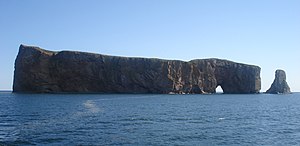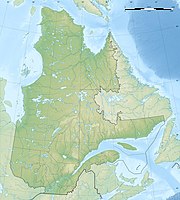Parc national de l'Île-Bonaventure-et-du-Rocher-Percé
|
Parc national de l'Île-Bonaventure-et-du-Rocher-Percé
|
||
|
The Rocher Percé |
||
| location | Quebec , Canada | |
| surface | 5.8 km² | |
| WDPA ID | 23128 | |
| Geographical location | ||
|
|
||
| Setup date | 1985 | |
| administration | Parcs Québec, SEPAQ | |
The Parc national de l'Île-Bonaventure-et-du-Rocher-Percé (loosely translated "Bonaventure Island National Park and Pierced Rock") is one of the currently 27 national parks in the Canadian province of Québec . There a parc national corresponds to what is called a provincial park in the other provinces . The park is operated by Sépaq ( French Société des établissements de plein air du Québec or English Society of outdoor recreation establishments of Quebec ).
The park is located near the port of Percé in the east of the Gaspésie peninsula on the Gulf of Saint Lawrence on the Île Bonaventure and its surroundings. The landmark of the place is the 88 m high and 438 m long limestone rock Rocher Percé , which can be reached on foot at low tide . The area was mainly placed under protection because it is home to the largest gannet colony in Canada, and according to other information even in the world, and numerous other migratory birds visit the Bonaventure island. The protected area for migratory birds covers almost 13 km², of which 467 hectares are land and 832 hectares are lakes. The park's director is Remi Plourde.
history
Around 1500 European fishermen, mainly Basques, Bretons and Irish, first reached the region around the island, but they did not settle. It was not until the British took over colonial rule in 1760 that settlement began and lasted until 1971. The grasslands in the west of the island, which were long thought to be natural, were probably created by local cultivation, i.e. logging, pasture farming, etc.
When Canada and the USA concluded an agreement on the protection of migratory birds in 1919 (Migratory Bird Convention of 1916), Bonaventure Island was placed under protection. In 1971, the province of Québec acquired the island and placed it under protection, followed by the pierced rock in 1974. In 1985 today's park was created, in which 293 bird species could be identified.
Flora and fauna
In the warm season, more than 60,000 pairs of northern gannets live in the park area, a total of more than 200,000 sea birds. In total there should be more than 350,000 birds in summer. In addition to the gannets are found primarily kittiwakes , for which the island next to Forillon and Anticosti is the most important sanctuary in the Gulf of Saint Lawrence (alone in these areas lived in 2010 71% of the animals), guillemots , terns , guillemots , auks , silver and black-headed gulls , razorbills , cormorants , ear shags , puffins and wood warblers . Especially for the birds, which cannot leave the island, too high a number of visitors represents a considerable danger, since the animals feel stressed and neglect their brood care. For these species (forest birds were last counted in 1998), but also for mammals, amphibians, reptiles and the inhabitants of coastal waters, inventories are to be made from 2011 onwards.
In addition, only a few mammals live on the island, such as the ermine , the snowshoe hare and the fox. There are also small representatives of the class, such as the white footed vole and the North American bank vole ( Myodes gapperi ). The small number of mammals, especially larger ones, is due to the habitat, which is very small and, above all, has almost no watercourses. In addition, the island lying 3.5 km off the coast can be reached in winter, but at this time many mammals are in hibernation. In addition, global warming ensures that there is no longer an adequate ice bridge to the mainland in winter. The two small fox families on the island are permanent residents.
See also
literature
- The research scientifique dans les Parcs nationaux québécois. Priorités et potentiels de recherche , published by Parcs Québec and Sépaq, undated, pp. 77–80.
- MC Bédard: Dégradation des glaces de mer et biogéographie des îles marines canadiennes , Université du Québec à Rimouski, 2008.
- M. Bourdage: Le bilan floristique de l'île Bonaventure. 1907-2008 , Mémoire de maîtrise de l'université Laval. 2009.
Web links
Remarks
- ↑ C. Pelletier: Inventaire des oiseaux forestiers nicheurs au parc de l'île-Bonaventure-et-du-Rocher-Percé, Été 1998 , published by the Ministère de l'environnement et de la Faune, Direction régionale de la Gaspésie-Îles -de-la-Madeleine, Service des parcs, 1998.




